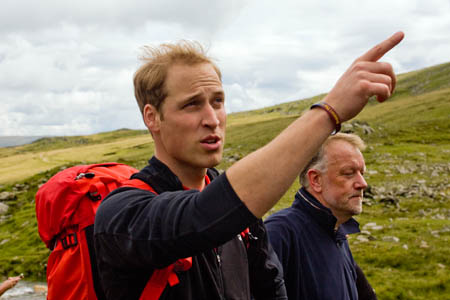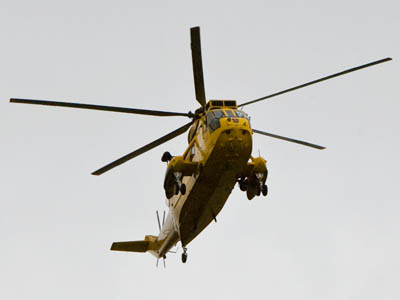
William on his way up Helvellyn last year with mountain rescuers
Prince William will join the search and rescue helicopter crews at a Welsh airbase if he passes his pilot training, it was announced today.
The man known as Flight Lieutenant Wales will be based at RAF Valley on Anglesey – on the doorstep of the mountains of Snowdonia, where much of the crews’ time is spent supporting the area’s mountain rescue teams.
Prince William, second in line to the throne, is also the patron of Mountain Rescue England & Wales, the umbrella body for the volunteer teams who operate south of the border.
The prince, who will be 28 in June, will initially be co-pilot of one of the RAF’s yellow Sea King 3A aircraft and will join a four-man crew operating in a wide swathe of western Britain and Northern Ireland.
He is due to complete his studies in September, when he is expected to join RAF Valley’s 22 Squadron, which normally operates two of the Sea King helicopters. Valley was the prince’s first choice of posting, his second being Lossiemouth in north-east Scotland.
A statement from St James’s Palace said: “The Royal Air Force’s decision to post Prince William to RAF Valley was made with the RAF’s interest in mind, matching Prince William’s skills to the challenges of flying sorties from RAF Valley.

The RAF Sea Kings usually have a crew of four. William will begin as co-pilot
“In particular, search and rescue operations from RAF Valley offer a wide variety of challenging flying over mountainous terrain and hostile seas supporting both military operations and civilian emergency services across the area.”
A normal tour of duty on the Search and Rescue Force is between 30 and 36 months. Each squadron maintains a 15-minutes readiness state during daylight hours and a 45-minutes readiness state at night.
Search and rescue Sea Kings are fitted with a multi-band homing system, satellite navigation systems and a search radar.
The aircraft have a hydraulically-operated main rescue hoist, an electrically-operated emergency rescue hoist and electrical connections suitable for powering medical equipment such as incubators. They are fitted with a video and infrared detection pod, which is similar to the equipment used by police helicopters, to help search for casualties.
All the crews are trained to operate using night-vision goggles over unfamiliar terrain. The standard crew is made up of four members: two pilots, one of whom is the aircraft captain, a radar operator who acts as the winch operator at the rescue scene and a winchman, normally trained to paramedic standard, who will supply immediate first-aid and recovery services at the rescue site.
The UK’s search and rescue service is due to be privatised progressively from 2012, when a fleet of Sikorsky S92A helicopters, operated by a business consortium, will replace the Sea Kings of the RAF and Royal Navy that currently operate in support of mountain rescue teams.
About 90 per cent of the work of the UK’s military search and rescue crews is on civilian rescue callouts.